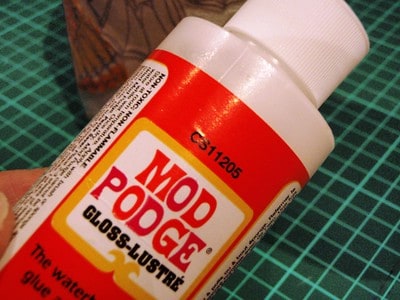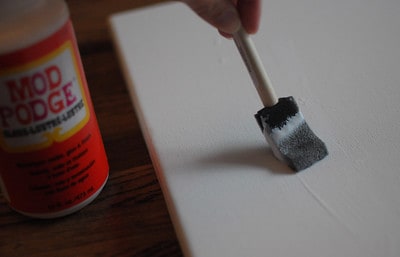Mod Podge is an amazing product because the formula is so versatile and can be used on several different surfaces, and for several different crafts. However, plastic tends to be very slick which makes it more difficult for the Mod Podge to adhere to. This article will help you understand how well Mod Podge mixes with plastic and how to properly apply it.
So, can you use Mod Podge on plastic? Yes, but keep in mind that some plastics are suitable for Mod Podge, while others are not. It depends on the shininess and porousness of the plastic. If there is nothing for the Mod Podge to grip to, it will peel off. It is recommended to prime the surface before applying Mod Podge.
Plastic is easier to use if it’s for a decoupage project, as you’ll be combining the plastic with a rougher material, like paper or fabric. This should reduce problems, but it is still advised to apply several coatings. If you want to seal or apply Mod Podge on any sort of plastic, you will need to prime the area first with an acrylic primer. Let’s learn more!
How to Use Mod Podge on Plastic

As stated above, the first thing you should do when applying Mod Podge to plastic is to do a sample. Cut out a small square of the plastic or use a small corner of your project, then leave it for at least 15 minutes to dry.
If you find that the Mod Podge can be easily peeled off, then it won’t work or offer any durability. If it seems secure, then you should be fine to continue. However, if you make any mistakes, it will still be possible to remove the Mod Podge, so don’t worry about that.
Once you’ve sampled your Mod Podge and not encountered issues, the next step is to layer the craft with the first coat of Mod Podge. With plastic, you should apply at least 3 thin coats, and wait for each layer to dry before adding another. Just like you would with any other material.

The process for decoupage is a little different. Here, you want to apply the Mod Podge to the most porous material first i.e the back of the fabric design. Apply a thin layer of Mod Podge onto the paper/fabric and firmly press it into the plastic. At this stage, it is recommended to keep the pressure on the decoupage to help it adhere correctly. This can be done by placing a heavier object on top such as a plank of wood.
This Mod Podge Decoupage Kit has everything you need to get started!

If you are trying to decoupage with non-porous materials such as beads or gems, you will need to use something stronger like super glue or E6000, or it won’t hold. Once you’ve finished, seal your entire craft in a layer of Mod Podge.
Does Modge Podge Dry Clear on Plastic?

The simple answer is yes. When Mod Podge is in the bottle it will appear white and mimic PVA glue. The white colour will carry on as you start to apply it, but as it dries it does go clear. The white colour should disappear within the first 15 minutes, however, the complete cure time for Mod Podge is 72 hours.
If you’ve applied Mod Podge to plastic and it hasn’t dried white then it’s most likely due to two reasons; exposure to moisture, or the layers being too thick. If Mod Podge is put outside or in damp rooms before it is given time to fully cure then it will react with the moisture and dry clumpy and white. Likewise, if the layers you’ve applied are too thick, then it will also dry white.
Check out one of my other articles that talks about Mod Podge Drying White. It answers all your questions you may have about why your Mod Podge dried white, and how to prevent/fix it.
If it’s the case that the Mod Podge has been introduced to moisture, you can try leaving it in a dry, warm room and it should sort itself out. However, if the whiteness is caused by the layers being too thick, then you’ll most likely need to remove the Mod Podge and start again.
Can You Use Dishwasher Safe Mod Podge on Plastic?

As stated above, plastic isn’t the most durable base for Mod Podge, so it’s very unlikely that your plastic craft will survive in the dishwasher. Dishwasher Safe Mod Podge is suitable for glass, ceramic, wood, and metal – however, nowhere on the formula does it recommend using plastic.
If attempted, you’d be running the risk of ruining your project by causing the Mod Podge to peel off. If it is absolutely necessary, then make sure the Mod Podge is very difficult to peel off before dishwashing it.
How Do You Mod Podge Pictures Onto Plastic?

If you are going to Mod Podge onto plastic, I would definitely recommend using a paper photocopy of the picture rather than the original. This is for two reasons, in case you make a mistake and can no longer preserve the original, and also because paper is much easier to Mod Podge than photographs.
Photographs are generally much thicker, and they also already come with a coating which makes them less porous and harder to glue. It’s not impossible, but it will make the overall appearance of your craft bumpy rather than flat.
Nonetheless, if you are using photos just make sure to apply more Mod Podge than usual (without making the layers too thick) so that they stay on properly. You should also hold the photos in place firmly for several minutes as the Mod Podge starts to dry to prevent them from sticking out or falling off.
I also recommend using this Mod Podge Photo Transfer Kit. It has everything you need to correctly transfer your photos, and make sure your project turns out great!

Now let’s talk about photocopied pictures. You want to make sure that you print the pictures on regular paper rather than photo paper, for the same reasons stated above. Then, spray both sides of the paper with an acrylic seal several times to prevent the picture from smudging when you apply the Mod Podge.
Once it has dried, paint both sides with a thin layer of Mod Podge and let it dry again. Then, you can continue to decoupage as normal by placing the picture into the plastic and painting the Mod Podge over it for two to three coats. It may sound like a lot of steps, but really it’s not much different from regular decoupage and it makes all the difference in the final results.
What Surfaces Can You Use Mod Podge On?

One of the best things about Mod Podge is that it can be used on almost any surface. Some of the popular options include wood, tin, ceramic, glass, craft foam, fabric, paper mache, and some plastics.

The only surfaces that aren’t suitable for Mod Podge are mainly those that are too slick such as polymer, Teflon, or silicone. Another one to avoid is felt. This is mainly because it soaks up too much of the Mod Podge and turns it hard and crusty.
Final Thoughts
Plastic is not the best surface for Mod Podge, but nonetheless, it can be done. In some cases, this may mean making some adjustments, such as with the decoupage process of sealing pictures onto plastic.
With this being said, no matter how well you Mod Podge plastic, it won’t be as durable as other surfaces such as wood, so for this reason, it is not recommended to put your plastic craft in the dishwasher or outside.
Make sure to follow all my tips and recommended products to ensure your Mod Podge project turns out great! Also, don’t forget to check out my other articles for all your painting Q&A’s. Happy painting!

